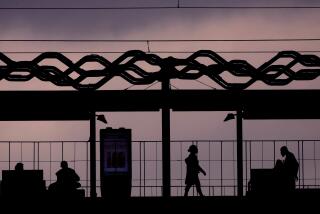Mayor backs chief’s second term
Citing a dramatic reduction in crime in Los Angeles, Mayor Antonio Villaraigosa said Tuesday that he supports giving Police Chief William J. Bratton a second five-year term.
Standing beside the sometimes outspoken chief during a police roll call at the Central Division station, Villaraigosa gave Bratton a surprisingly early endorsement, considering that the Police Commission won’t formally take up the issue until March, although it recently gave him its highest possible rating in an annual performance review.
Bratton’s current term ends in October.
If he is retained, Bratton would be the first chief to be kept on since the 1992 revisions of the City Charter, which gave the civilian Police Commission power to reappoint the chief.
The progressive Latino mayor’s backing of a tough-on-crime chief is all the more meaningful because Bratton was appointed by former Mayor James K. Hahn, whom Villaraigosa defeated in the 2005 election.
The mayor made his comments at a news conference, noting that the overall 7.7% reduction in serious crime marked the fifth consecutive year of decline -- now to a rate last seen in 1956.
Gang-related crime increased about 14% through November, and Bratton said he intends to make that a department focus in the year ahead.
“I think the numbers speak for themselves,” Villaraigosa said. “The fact that morale is up in the department. Crime is down in almost every category. The fact that we are the second-safest big city in America with only half the resources that New York has. The fact that we haven’t been, on a per-capita basis, as safe as we are in Los Angeles since I was 3 years old in 1956. So I can tell you I do support another five-year term for Chief Bratton.”
The mayor’s support should carry a lot of weight, because Villaraigosa appoints the five members of the Police Commission. For his part, Bratton said he hopes to serve another five years as chief.
“I’m very interested in it,” Bratton said. “Quite clearly, when you look at the numbers, there is quite a bit more to be done.”
In particular, the two city officials said they were concerned about the increase in gang-related crime, including what Bratton described as an “uptick” in high-profile gang-related crimes between Latinos and African Americans.
“As crime continues to drop overall, we begin to see a glaring exception to that trend -- gang crime,” Villaraigosa said. “Street gangs are responsible for a majority of all murders in Los Angeles. Street gangs are becoming more violent, specifically in the East Valley, the Eastside and South L.A. neighborhoods.”
The greatest surge was in the San Fernando Valley, where gang-related crime rose by 42.4% in 2006, according to preliminary Los Angeles Police Department statistics.
Gang-related homicides decreased by 2% over the same period, while gang-related attempted homicides, assaults and robberies rose.
The chief said 56% of the 478 homicides last year in Los Angeles were gang-related, 86% of the victims were African American or Latino and 92% of the suspects were African American or Latino.
The vast majority of gang violence is not interracial but black on black or Latino on Latino, Villaraigosa said.
“Our New Year’s resolution in 2007 is to make violent street gangs Public Enemy No. 1,” the mayor said.
Villaraigosa was scheduled to board a jet Tuesday night to fly to Washington, D.C., where he plans to ask U.S. Atty. Gen. Alberto Gonzalez for more federal assistance in the struggle against street gangs, including resources to address those attacks in which race may be a factor.
“An aggressive assault on gang crime will require more resources than the LAPD currently has,” the mayor said, adding that he would make a similar request for help from the Los Angeles County district attorney and state officials.
Bratton said he plans to announce a new strategy for reducing crime in the coming weeks.
A string of incidents in neighborhoods including the Harbor Gateway area where gang members appeared to have attacked people based on race has been particularly troubling.
“That’s something we cannot and will not tolerate,” Bratton said.
The chief warned that a large number of officers’ retirements and lagging recruitment means that the police force would probably not expand its street presence this year, but Villaraigosa endorsed the idea of paying overtime to put more officers in neighborhoods until hiring catches up.
*
tony.barboza@latimes.com
*
(BEGIN TEXT OF INFOBOX)
L.A. crime statistics
Serious crimes citywide were down 7.7% last year, compared to 2005, while such crimes linked to gangs rose 14% through November, according to the Los Angeles Police Department. Here’s a look at the 2005 to 2006 percent changes by LAPD area:
Serious crimes
2005-2006 LAPD comparison
Percent change
S. F. Valley: -3.1
West L.A.: -13.4
Central: -9.5
South: -6.0
**
Gang-related serious crimes
2005-2006 comparison through November.
Percent change
S. F. Valley: 42.2
West L.A.: -8.3
Central: 2.6
South: 24.3
*
Note: The LAPD considers serious crimes, known as Part I crimes, to include: homicide, rape, robbery, aggravated assaults, burglary, auto theft, burglary from a vehicle, and other theft.
Source: LAPD. Compiled by Cheryl Brownstein-Santiago
More to Read
Sign up for Essential California
The most important California stories and recommendations in your inbox every morning.
You may occasionally receive promotional content from the Los Angeles Times.












